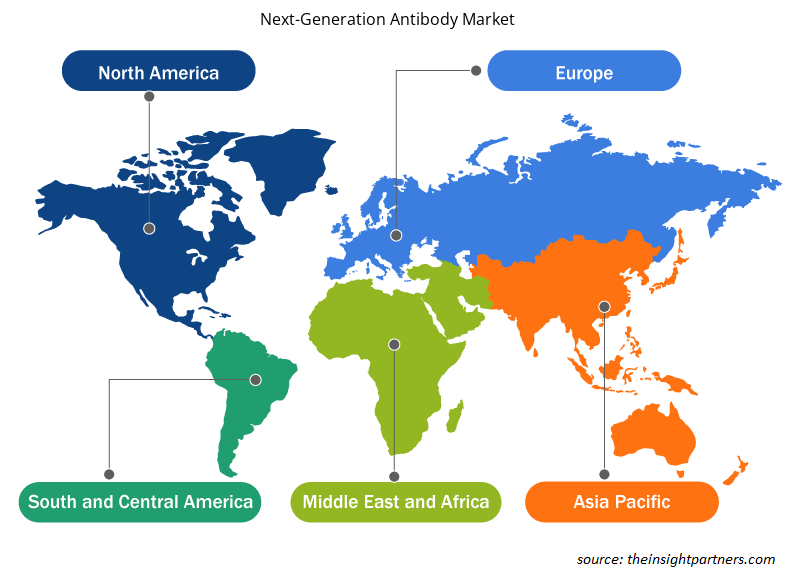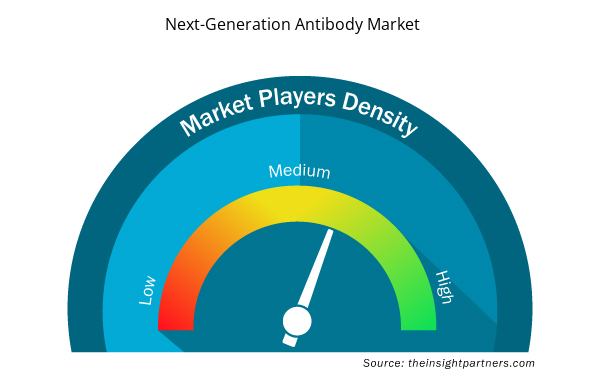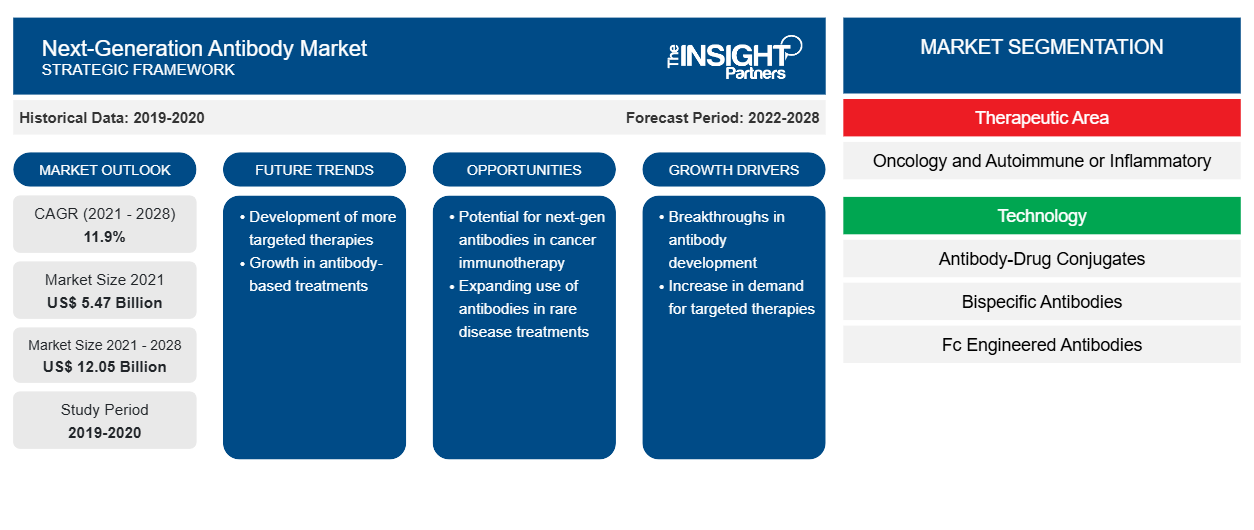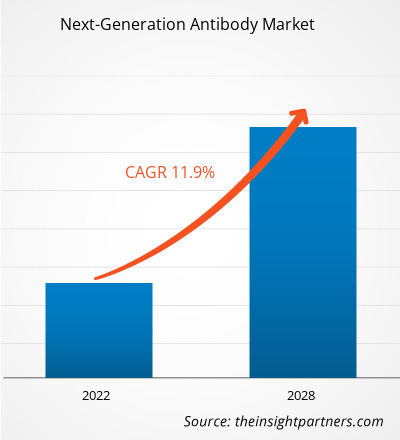Der Markt für Antikörper der nächsten Generation soll von 5.468,41 Millionen US-Dollar im Jahr 2021 auf 12.050,13 Millionen US-Dollar im Jahr 2028 anwachsen; von 2021 bis 2028 wird mit einer durchschnittlichen jährlichen Wachstumsrate von 11,9 % gerechnet.
Antikörper der nächsten Generation sind spezifischer und oft wirksamer als herkömmliche monoklonale Antikörper. Antikörperstrategien der nächsten Generation sind erforderlich, um ein nützliches Therapeutikum zu entwickeln, das Antikörper, Nutzlast, Linker und Konjugationsmethode kombiniert und gleichzeitig Stabilität, gezielte Verabreichung und begrenzte unerwünschte Effekte gewährleistet.
Der Bericht bietet Einblicke und eine eingehende Analyse des Marktes für Antikörper der nächsten Generation und hebt dabei verschiedene Parameter wie Markttrends, technologische Fortschritte, Marktdynamik und Wettbewerbslandschaftsanalysen führender Marktteilnehmer weltweit hervor. Er umfasst auch die Auswirkungen der COVID-19-Pandemie auf den Markt in allen Regionen. Die Pandemie hat die sozioökonomischen Bedingungen verschiedener Länder auf der ganzen Welt gestört. Derzeit sind die USA aufgrund des COVID-19-Ausbruchs das am schlimmsten betroffene Land der Welt mit der höchsten Zahl bestätigter Fälle und Todesfälle weltweit, wie aus den jüngsten WHO-Statistiken hervorgeht. Die hohe Zahl der COVID-19-positiven Fälle hat sich negativ auf die Weltwirtschaft ausgewirkt. Es kam zu einem Rückgang der gesamten Geschäftstätigkeit und des Wachstums verschiedener weltweit tätiger Branchen.
Passen Sie diesen Bericht Ihren Anforderungen an
Sie erhalten kostenlos individuelle Anpassungen an jedem Bericht, einschließlich Teilen dieses Berichts oder einer Analyse auf Länderebene, eines Excel-Datenpakets sowie tolle Angebote und Rabatte für Start-ups und Universitäten.
- Holen Sie sich die wichtigsten Markttrends aus diesem Bericht.Dieses KOSTENLOSE Beispiel umfasst eine Datenanalyse von Markttrends bis hin zu Schätzungen und Prognosen.
Der COVID-19-Ausbruch hat die Gesundheitsinfrastruktur in den USA, Kanada und Mexiko enorm belastet. Darüber hinaus sind die meisten Pharma- und Biotechnologieunternehmen und Forschungsinstitute mit der Entwicklung von COVID-19-Impfstoffen und -Medikamenten beschäftigt. Sowohl etablierte Pharmaunternehmen als auch kleine Start-ups haben sich gemeldet, um Behandlungen und Impfstoffe zu entwickeln, die auf die durch das neuartige Coronavirus verursachte Infektion abzielen. Infolgedessen werden impfstoffbezogene Forschungsaktivitäten in Pharma- und Biotechnologieunternehmen, Forschungszentren und Bildungsforschungsinstituten als unverzichtbar anerkannt und sind in Betrieb und Produktion weitgehend unbeeinträchtigt geblieben. Aufgrund der Zunahme der Forschungsaktivitäten wird jedoch erwartet, dass sowohl die Verfügbarkeit von Finanzmitteln für Analysen als auch der Bedarf an Antikörpern, einschließlich Antikörpern der nächsten Generation, steigen werden. Darüber hinaus sind im Vorfeld des COVID-19-Ausbruchs viele Forscher weltweit an der Virusuntersuchung von SARS-CoV-2 beteiligt, dem Virus, das COVID-19 entwickelt. Sowohl für Impfstoffe als auch für Therapeutika werden die erzeugten Antikörper auf ihre funktionelle Effizienz untersucht, um dem Zielvirus entgegenzuwirken. Daher wird erwartet, dass sich die COVID-19-Pandemie in den kommenden Jahren positiv auf den Markt für Antikörper der nächsten Generation auswirken wird.
Regional ist der Markt für Antikörper der nächsten Generation in Nordamerika, Europa, den asiatisch-pazifischen Raum, den Nahen Osten und Afrika sowie Süd- und Mittelamerika segmentiert.
Markteinblicke
Wachsende Nachfrage nach Antikörpertherapeutika der nächsten Generation treibt den Markt für Antikörper der nächsten Generation an
Die zunehmende Entwicklung in der Biotechnologie hat zu einer zunehmenden Akzeptanz von Antikörpertherapeutika der nächsten Generation geführt, was ihren Einsatz in der Behandlung von Autoimmun-, Entzündungs- und chronischen Krankheiten vorantreibt. Antikörperbehandlungen der nächsten Generation sind das Ergebnis der Anwendung hochentwickelter Technologien in der Antikörpertherapie, wie Antikörper-Wirkstoff-Konjugaten (ADCs), glykoengineerten Antikörpern und spezifischen Antikörpern (BsAbs). Daher werden Anwendungen von Antikörpern der nächsten Generation zur Behandlung verschiedener chronischer Krankheiten wie Krebs, HIV, Infektionskrankheiten usw. umfassend untersucht. Die steigende Nachfrage nach diesen Antikörpern hat zu einer raschen Zunahme der Zulassung von ADCs und anderen Antikörpertherapeutika der nächsten Generation geführt. So gab Takeda Pharmaceutical Company Limited im Mai 2020 die FDA-Zulassung von ALUNBRIG (Brigatinib) für erwachsene Patienten mit anaplastischem Lymphomkinase-positivem (ALK+) metastasiertem nicht-kleinzelligem Lungenkrebs (NSCLC) bekannt, der durch einen von der FDA zugelassenen Test nachgewiesen wurde. Die aktuelle Indikation von ALUNBRIG wurde mit der Zulassung auf die Erstlinienbehandlung ausgeweitet. ALUNBRIG ist ein Tyrosinkinase-Inhibitor (TKI) der nächsten Generation, der auf molekulare ALK-Anomalien abzielt. Ebenso gab Genentech 2019 die beschleunigte FDA-Zulassung von Polatuzumab vedotin-piiq bekannt, einem CD79b-gerichteten Antikörper-Wirkstoff-Konjugat, das in Kombination mit Bendamustin und einem Rituximab-Produkt für erwachsene Patienten mit rezidiviertem oder refraktärem diffusem großzelligem B-Zell-Lymphom angezeigt ist.
Daher wird erwartet, dass der Markt für Antikörper der nächsten Generation im Prognosezeitraum aufgrund der zunehmenden Zulassungen für klinische Studien und der hohen Akzeptanz von Antikörpertherapeutika der nächsten Generation zur Behandlung verschiedener Krankheiten schnell wachsen wird.
Erkenntnisse auf der Grundlage therapeutischer Bereiche
Basierend auf dem Therapiebereich ist der Markt für Antikörper der nächsten Generation in Onkologie und Autoimmun- bzw. Entzündungskrankheiten unterteilt. Der Onkologiebereich hatte einen größeren Marktanteil.
Technologiebasierte Erkenntnisse
Basierend auf der Technologie ist der Markt für Antikörper der nächsten Generation in Antikörper-Wirkstoff-Konjugate , bispezifische Antikörper, Fc-konstruierte Antikörper, Antikörperfragmente und antikörperähnliche Proteine sowie bioähnliche Antikörperprodukte segmentiert. Das Segment der Antikörper-Wirkstoff-Konjugate hatte 2021 den größten Marktanteil und wird im Prognosezeitraum voraussichtlich die höchste durchschnittliche jährliche Wachstumsrate (CAGR) von 12,1 % auf dem Markt verzeichnen.
Die Akteure auf dem Markt für Antikörper der nächsten Generation verfolgen verschiedene organische Strategien, wie etwa Produkteinführung und -erweiterung, um ihre Präsenz und ihr Produktportfolio weltweit zu erweitern und der steigenden Nachfrage gerecht zu werden.
Regionale Einblicke in den Markt für Antikörper der nächsten Generation
Die regionalen Trends und Faktoren, die den Markt für Antikörper der nächsten Generation während des gesamten Prognosezeitraums beeinflussen, wurden von den Analysten von Insight Partners ausführlich erläutert. In diesem Abschnitt werden auch Marktsegmente und Geografien für Antikörper der nächsten Generation in Nordamerika, Europa, im asiatisch-pazifischen Raum, im Nahen Osten und Afrika sowie in Süd- und Mittelamerika erörtert.

- Erhalten Sie regionale Daten zum Markt für Antikörper der nächsten Generation
Umfang des Marktberichts zu Antikörpern der nächsten Generation
| Berichtsattribut | Details |
|---|---|
| Marktgröße im Jahr 2021 | 5,47 Milliarden US-Dollar |
| Marktgröße bis 2028 | 12,05 Milliarden US-Dollar |
| Globale CAGR (2021 - 2028) | 11,9 % |
| Historische Daten | 2019-2020 |
| Prognosezeitraum | 2022–2028 |
| Abgedeckte Segmente | Nach Therapiebereich
|
| Abgedeckte Regionen und Länder | Nordamerika
|
| Marktführer und wichtige Unternehmensprofile |
|
Marktteilnehmerdichte: Der Einfluss auf die Geschäftsdynamik
Der Markt für Antikörper der nächsten Generation wächst rasant. Die Nachfrage der Endverbraucher steigt aufgrund von Faktoren wie sich entwickelnden Verbraucherpräferenzen, technologischen Fortschritten und einem größeren Bewusstsein für die Vorteile des Produkts. Mit der steigenden Nachfrage erweitern Unternehmen ihr Angebot, entwickeln Innovationen, um die Bedürfnisse der Verbraucher zu erfüllen, und nutzen neue Trends, was das Marktwachstum weiter ankurbelt.
Die Marktteilnehmerdichte bezieht sich auf die Verteilung der Firmen oder Unternehmen, die in einem bestimmten Markt oder einer bestimmten Branche tätig sind. Sie gibt an, wie viele Wettbewerber (Marktteilnehmer) in einem bestimmten Marktraum im Verhältnis zu seiner Größe oder seinem gesamten Marktwert präsent sind.
Die wichtigsten Unternehmen auf dem Markt für Antikörper der nächsten Generation sind:
- F. HOFFMANN-LA ROCHE LTD.
- Kyowa Kirin Co., Ltd.
- Seagen Inc.
- ImmunoGen, Inc.
- Takeda Pharmaceutical Company Limited
Haftungsausschluss : Die oben aufgeführten Unternehmen sind nicht in einer bestimmten Reihenfolge aufgeführt.

- Überblick über die wichtigsten Akteure auf dem Markt für Antikörper der nächsten Generation
Firmenprofile
- F. HOFFMANN-LA ROCHE LTD.
- Kyowa Kirin Co., Ltd.
- Seagen Inc.
- ImmunoGen, Inc.
- Takeda Pharmaceutical Company Limited
- Amgen Inc.
- Pfizer Inc.
- Catalent Inc
- AstraZeneca
- Xencor
- Historische Analyse (2 Jahre), Basisjahr, Prognose (7 Jahre) mit CAGR
- PEST- und SWOT-Analyse
- Marktgröße Wert/Volumen – Global, Regional, Land
- Branche und Wettbewerbsumfeld
- Excel-Datensatz



Report Coverage
Revenue forecast, Company Analysis, Industry landscape, Growth factors, and Trends

Segment Covered
This text is related
to segments covered.

Regional Scope
North America, Europe, Asia Pacific, Middle East & Africa, South & Central America

Country Scope
This text is related
to country scope.
Häufig gestellte Fragen
The global next-generation antibody market is expected to reach US$ 5,428.41 million in 2028 from US$ 12,050.13 million in 2021. The market is estimated to grow with a CAGR of 11.9% from 2021-2028.
The next-generation antibodies are used in the therapeutic areas- oncology and oncology, and autoimmune or inflammatory. Mostly, the next-generation antibodies are used in the oncology field. The oncology segment is likely to hold the largest share of the market in 2021. Moreover, the oncology segment is anticipated to register the highest CAGR in the market during the forecast period, due to the vast usage of next-generation antibodies for cancers, high volume consumption, and product innovation for this field
The disposable pipettes tips market majorly consists of players like F. HOFFMANN-LA ROCHE LTD., Kyowa Kirin Co., Ltd., Seagen Inc., ImmunoGen, Inc., Takeda Pharmaceutical Company Limited, Amgen Inc., Pfizer Inc., Catalent Inc, AstraZeneca, and Xencor among others.
The growth of the market is attributed to the increasing prevalence of cancer and growing demand for next-generation antibody therapeutics drives the market growth. However, the complications associated with the manufacturing and approvals hampers the market growth.
The Asia Pacific registered as the fastest-growing region in the global next-generation antibody market. The market in this region is expected to grow significantly in countries such as China, Japan, and India. The market is driven by growing investments from international players in China and India, improving government support in countries such as China, expanding R&D, and advancing healthcare infrastructure. Therefore, the region holds huge potential for the next-generation antibody market players to grow during the forecast period.
Trends and growth analysis reports related to Life Sciences : READ MORE..
The List of Companies - Next-generation Antibody Market
- F. HOFFMANN-LA ROCHE LTD.
- Kyowa Kirin Co., Ltd.
- Seagen Inc.
- ImmunoGen, Inc.
- Takeda Pharmaceutical Company Limited
- Amgen Inc.
- Pfizer Inc.
- Catalent Inc
- AstraZeneca
- Xencor
The Insight Partners performs research in 4 major stages: Data Collection & Secondary Research, Primary Research, Data Analysis and Data Triangulation & Final Review.
- Data Collection and Secondary Research:
As a market research and consulting firm operating from a decade, we have published and advised several client across the globe. First step for any study will start with an assessment of currently available data and insights from existing reports. Further, historical and current market information is collected from Investor Presentations, Annual Reports, SEC Filings, etc., and other information related to company’s performance and market positioning are gathered from Paid Databases (Factiva, Hoovers, and Reuters) and various other publications available in public domain.
Several associations trade associates, technical forums, institutes, societies and organization are accessed to gain technical as well as market related insights through their publications such as research papers, blogs and press releases related to the studies are referred to get cues about the market. Further, white papers, journals, magazines, and other news articles published in last 3 years are scrutinized and analyzed to understand the current market trends.
- Primary Research:
The primarily interview analysis comprise of data obtained from industry participants interview and answers to survey questions gathered by in-house primary team.
For primary research, interviews are conducted with industry experts/CEOs/Marketing Managers/VPs/Subject Matter Experts from both demand and supply side to get a 360-degree view of the market. The primary team conducts several interviews based on the complexity of the markets to understand the various market trends and dynamics which makes research more credible and precise.
A typical research interview fulfils the following functions:
- Provides first-hand information on the market size, market trends, growth trends, competitive landscape, and outlook
- Validates and strengthens in-house secondary research findings
- Develops the analysis team’s expertise and market understanding
Primary research involves email interactions and telephone interviews for each market, category, segment, and sub-segment across geographies. The participants who typically take part in such a process include, but are not limited to:
- Industry participants: VPs, business development managers, market intelligence managers and national sales managers
- Outside experts: Valuation experts, research analysts and key opinion leaders specializing in the electronics and semiconductor industry.
Below is the breakup of our primary respondents by company, designation, and region:

Once we receive the confirmation from primary research sources or primary respondents, we finalize the base year market estimation and forecast the data as per the macroeconomic and microeconomic factors assessed during data collection.
- Data Analysis:
Once data is validated through both secondary as well as primary respondents, we finalize the market estimations by hypothesis formulation and factor analysis at regional and country level.
- Macro-Economic Factor Analysis:
We analyse macroeconomic indicators such the gross domestic product (GDP), increase in the demand for goods and services across industries, technological advancement, regional economic growth, governmental policies, the influence of COVID-19, PEST analysis, and other aspects. This analysis aids in setting benchmarks for various nations/regions and approximating market splits. Additionally, the general trend of the aforementioned components aid in determining the market's development possibilities.
- Country Level Data:
Various factors that are especially aligned to the country are taken into account to determine the market size for a certain area and country, including the presence of vendors, such as headquarters and offices, the country's GDP, demand patterns, and industry growth. To comprehend the market dynamics for the nation, a number of growth variables, inhibitors, application areas, and current market trends are researched. The aforementioned elements aid in determining the country's overall market's growth potential.
- Company Profile:
The “Table of Contents” is formulated by listing and analyzing more than 25 - 30 companies operating in the market ecosystem across geographies. However, we profile only 10 companies as a standard practice in our syndicate reports. These 10 companies comprise leading, emerging, and regional players. Nonetheless, our analysis is not restricted to the 10 listed companies, we also analyze other companies present in the market to develop a holistic view and understand the prevailing trends. The “Company Profiles” section in the report covers key facts, business description, products & services, financial information, SWOT analysis, and key developments. The financial information presented is extracted from the annual reports and official documents of the publicly listed companies. Upon collecting the information for the sections of respective companies, we verify them via various primary sources and then compile the data in respective company profiles. The company level information helps us in deriving the base number as well as in forecasting the market size.
- Developing Base Number:
Aggregation of sales statistics (2020-2022) and macro-economic factor, and other secondary and primary research insights are utilized to arrive at base number and related market shares for 2022. The data gaps are identified in this step and relevant market data is analyzed, collected from paid primary interviews or databases. On finalizing the base year market size, forecasts are developed on the basis of macro-economic, industry and market growth factors and company level analysis.
- Data Triangulation and Final Review:
The market findings and base year market size calculations are validated from supply as well as demand side. Demand side validations are based on macro-economic factor analysis and benchmarks for respective regions and countries. In case of supply side validations, revenues of major companies are estimated (in case not available) based on industry benchmark, approximate number of employees, product portfolio, and primary interviews revenues are gathered. Further revenue from target product/service segment is assessed to avoid overshooting of market statistics. In case of heavy deviations between supply and demand side values, all thes steps are repeated to achieve synchronization.
We follow an iterative model, wherein we share our research findings with Subject Matter Experts (SME’s) and Key Opinion Leaders (KOLs) until consensus view of the market is not formulated – this model negates any drastic deviation in the opinions of experts. Only validated and universally acceptable research findings are quoted in our reports.
We have important check points that we use to validate our research findings – which we call – data triangulation, where we validate the information, we generate from secondary sources with primary interviews and then we re-validate with our internal data bases and Subject matter experts. This comprehensive model enables us to deliver high quality, reliable data in shortest possible time.


 Holen Sie sich ein kostenloses Muster für diesen Bericht
Holen Sie sich ein kostenloses Muster für diesen Bericht